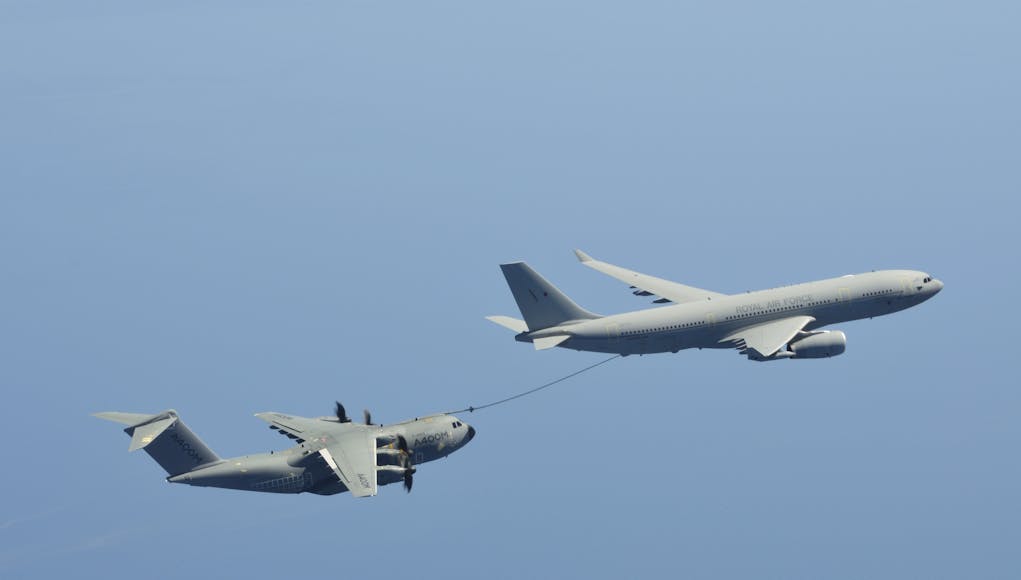Aerial refuelling, also known as air refuelling or in-flight refuelling, is a process in which one aircraft transfers fuel to another aircraft while in flight.
This allows the receiving aircraft to extend its range and stay in the air for longer periods of time without needing to land for refuelling.
Aerial refuelling is typically performed using a specialised aircraft called a tanker, which is equipped with a hose and drogue system or a flying boom.
The tanker flies alongside the receiving aircraft, and the two planes are connected using the hose and drogue or the flying boom. The tanker then transfers fuel to the receiving aircraft through this connection.
There are several benefits to using aerial refuelling. One of the main advantages is that it allows military aircraft to carry out long-range missions without needing to land.
This can be especially useful in situations where it is not possible or safe to land, such as in combat zones or areas with limited infrastructure.
Aerial refuelling can also increase the flexibility of military operations. By allowing aircraft to stay in the air for longer periods of time, aerial refuelling enables them to respond more quickly to changing situations on the ground.
This can be particularly useful in situations where a rapid response is needed, such as in disaster relief operations or search and rescue missions.
What is the difference between Probe-and-drogue and boom?
Probe-and-drogue and boom are two different methods of transferring fuel between aircraft in flight, also known as aerial refuelling.
The probe-and-drogue system involves the use of a flexible hose with a cone-shaped basket, called a drogue, attached to the end. The tanker aircraft releases the drogue from a dispenser, and the receiving aircraft extends a probe to connect to the drogue. The tanker then transfers fuel to the receiving aircraft through the hose.
The boom system, on the other hand, uses a rigid, telescoping boom that is operated by a boom operator on the tanker aircraft. The boom extends from the tanker and is guided into position by the boom operator, who uses a visual control panel to align the boom with the receiving aircraft’s refuelling receptacle. Once the boom is connected, the tanker transfers fuel to the receiving aircraft through the boom.
One key difference between the two systems is the level of control and precision involved. The probe-and-drogue system relies on the pilots of both aircraft to maintain a stable, connected position, which can be challenging in high-speed or turbulent conditions. The boom system, on the other hand, allows the boom operator to take over the task of aligning the boom and maintaining a stable connection, which can provide more accurate and efficient refuelling.














Any hope for boom addition to Voyager in the foreseeable future? Would enhance interoperability w/ USAF.
Although It would be useful I doubt it. The RAF can’t refuel its P8, C17, rivet joint, E7. In past years the Uk would stick a probe onto any aircraft but doesn’t seem to do that anymore either.
USAF has boom equipped tankers based in the UK. Time for a deal?
The main advantage to each system is transfer rate vs adaptability:
Transfer rate, boom system can transfer more fuel and is therefore used often on large aircraft.
Adaptability, The drogue is less complex than the boom system and can be used on a wider variety of aircraft including helicopters. You can even strap a drogue system onto a fighter and make it a tanker.
I’d also argue against the notion that the boom operator is exclusively controlling the process on a boom system. They are definitely doing a large share of work but I have flown with pilot’s who had a hard time closing in then staying behind a tanker. Especially when the aircraft is near its performance limitations. (i.e. a heavy C-130!)
an upgrade of the mrtt would be nice and well needed on the boom side of things, with 4 different types of aircraft coming or being in RAF service ( wedgetails, peosiden , and rivet joint , c-17 ) as well as interoperability with USAF and others , along with airbus SMART upgrades and maybe a top cargo door for combo ops? i swear ive seen that somewhere.
Another advantage of modern booms, as pioneered by Airbus and now also on the KC-46, is that the booms are fly-by-wire and have a great degree of built-in stability control and compensate automatically for receiving aircraft movements
Airbus needs to start the transition from A330-200 to A330-800 for the MRTT. The process will take 5 to 7 years, as the B737 Max disasters, means re-engined aircraft will be subject to far more regulatory scrutiny. So before people moan, the A330-800 MRTT is not for 2022, it is for 2030.
Re-engining is not an issue in most cases…. Afaik, the problem with the 737 max was that, due to the slim turbojet Engines used for the original version, the aircraft / wing was too low for the more efficient but fatter, higher bypass ratio engine they upgraded to. This meant they had to be mounted higher and further forward than ideal causing issues with centre of gravity, lift and thrust that had to be solved with the flight control system. This led to the flaw. Most aircraft like the a330 always had large turbofan engines so no reason to expect problems if the designers do their job properly.
It should be straightforward to switch MRTT from the A330-200 to the -800, but the regulators will want every aircraft currently cleared to refuel with a 200, to be trialed again with an 800. They will not take it as read. You can thank the B737 Max for that.